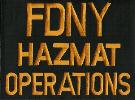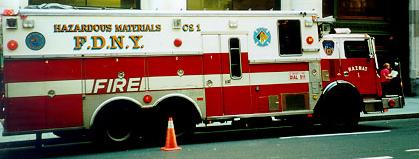Remembering the 9/11 Heroes of the FDNY's Hazardous Materials Company 1
Remembering the 9/11 Heroes of the
FDNY's Hazardous Materials Company 1
On the morning of Tuesday, September 11th, 2001, a band of al-Qaida terrorists hijacked four commercial airliners from several airports in the Atlantic (East Coast) region of the United States. The terrorists flew two of those hijacked aircraft into the two towers of the World Trade Center situated in the heart of Manhattan's financial district downtown. The third plane struck the Pentagon - headquarters of the U.S. military near Washington D.C., while a fourth was intially destine to target either the U.S. Capitol or the White House but the passengers onboard, alerted to the fact that the hijackers intended to use the plane as a weapon fought back forcing the hijackers to crash the plane in a rural field in Pennsylvania, killing all on board.
The New York City Fire Department's Hazardous Materials Company No. 1 responded to the now dual towering inferno at the World Trade Center in Lower Manhattan as did thousands of other members of various ranks and units within the FDNY. In fact, the FDNY issued a total recall (the first ever in it's history) requiring all firefighters - whether on-duty or off - to come in to work.
FDNY chiefs responding to the incident were keenly aware of the level of danger going in to this crisis and more than a few were even heard to say, "We're going to lose men on this one." This crisis was unlike any that the FDNY or any other fire department has ever faced.
Thousands were still inside when the towers collapsed. Most of those still inside were office workers but there were also several hundred firefighters as well as several dozen police officers, paramedics, EMTs and other emergency responders fighting fires and trying to evacuate office workers.
The firefighters are fondly remembered by the office workers who were fortunate enough to escape before the towers collapsed as "the men who were going up while everyone else was racing down and out of the buildings to safety."
At least 2,800 people died in the 9/11 attacks, including 343 members of the FDNY. Of that number eleven members of FDNY HAZMAT perished. Those 11 men were inside the South Tower (Tower 2) assisting in the evacuation of people when it collapsed.
Never in history has a HAZMAT team lost so many members in a single incident.
That day was the darkest in the history of NYC and one of the darkest in overall American history.
At the time of the attacks the FDNY's HAZMAT company had 39 members on it's roster (four officers and 35 firefighters).
The specialized outfit is based in Maspeth, a neighborhood in the New York City borough of Queens that is a mixed surburban, rural and lightly industrial area. It is from here FDNY HAZMAT responds to incidents at any location in the five boroughs (Queens, Manhattan, Bronx, Brooklyn and Staten Island) that comprise the 310 square mile entity that is known to the world as New York City.
FDNY HAZMAT shares their quarters with Squad 288. The two often work closely with one another and have a special relationship. Squad 288 which responded alongside with HAZMAT on 9/11 to the World Trade Center lost eight men on that dark day. The 11 men lost in HAZMAT and the eight lost in Squad 288 made a combined total of 19 men lost which gave the Maspeth quarters the dark distinction of having the most number of men lost from a single firehouse in the 9/11 attacks.
A total of 51 children – from teenagers to a 2-week old baby – were left fatherless when the firefighters of HAZMAT and Squad 288 perished.
The unit was absolutely decimated by the tragedy at the World Trade Center and lost a great deal of it's vital resources. The team's main HAZMAT response truck along with a library that included countless MSDS (Material Safery Data Sheets) and other documents as well as hundreds of thousands of dollars worth of high-tech HAZMAT equipment were buried and destroyed under the crush of rubble from the falling towers. Also destroyed were hundreds of other FDNY, NYPD and ambulance apparatus.
The FDNY was hit really hard by the 9/11 disaster. Many of the 343 lost were the best and brightest of that agency. Special units as well as experienced veterans and a large portion of the FDNY leadership were killed in that single incident. It was a devestating blow for not just the FDNY but the city as a whole and for a short time put a severe strain on it's abilities to respond to disasters both man-made and natural.
All of the FDNY's elite five Rescue squads suffered heavy losses and were nearly wiped out on 9/11. However, the Rescue squads were able to refill their ranks much quicker than HAZMAT was able to. The FDNY's Rescue squads are a popular destination for many career firefighters. The Rescue squads and the work that they do are typically more high-profile and attractive than HAZMAT. Also, the subject of qualified candiates is an issue when it comes to recruitment for a HAZMAT team. There are occassions when someone will volunteer to join a HAZMAT team but because they don't have a fairly good grasp on basic chemistry and related concepts, they are unable to make the cut.
The surviving members of the FDNY HAZMAT company noted the talent drain that was caused by the loss of nearly a dozen of it's members and it's leadership on 9/11. The majority of the members lost in this specialized outfit were the most experienced and senior. In fact, some of the members lost on 9/11 had been with FDNY HAZMAT since it's early beginnings in 1983.
Many of the members of HAZMAT wanted to go down to the collapsed ruins of the World Trade Center and work with other FDNY firefighters to unearth the remains of those lost in the elite outfit on that tragic Tuesday morning but city officials refused to allow them to do so. The city (as well as the rest of the nation) was on high alert for another terrorist attack, especially one involving Chemical, Biological, Radiological and/or Nuclear (CBRN) weapons and felt that it would not be a good use of HAZMAT - whose resources were already greatly depleted - to work at the ruins of the World Trade Center unearthing remains. There were already hundreds of FDNY, NYPD and construction workers performing that task, HAZMAT was a rare resource and City Hall wanted it in place to immediately respond to any CBRN attack.
In fact, while still recovering from their 9/11 losses and with their ranks greatly depleted, the specialized squad was pressed into service as never before as it responded to a series of postal-based terror attacks involving the biological weapon, anthrax, that was being used to terrorize news media centers in Midtown Manhattan as well as in other places in the nation in Autumn 2001.
CBRN terrorism was a high concern for FDNY HAZMAT even before the rest of the nation became concerned about it after 9/11. FDNY HAZMAT spent much of the late 1990's studying "exotic" hazmat incidents, namely those involving CBRN as well as studying terrorism. FDNY HAZMAT was also training other units in the FDNY and other city agencies in CBRN response and conducting training exercises.
In light of 9/11, the city has taken special steps to ensure that at least some of the special services provided by HAZMAT will still be available to the city even if the entire unit was wiped out in a terrorist attack or disaster. Outside of the HAZMAT unit itself, there are now 1,000 firefighters that have HAZMAT training. Most of those firefighters are in FDNY's Squads. The Squads, of which there are seven that are strategically stationed throughout the city, are under the command of FDNY Special Operations Command (as are HAZMAT and the Rescue companies) and are described as a "squad/special service company." Many of the firefighters in the Squads are trained to the technician level of HAZMAT response. Squads respond to HAZMAT incidents and assist engine and ladder companies and other FDNY units. If possible they will resolve the incident on their own or contain the situation until the HAZMAT team arrives.
The Squads are also certified Rescue Technicians and are trained in all facets of technical rescue including but not limited to: structural collapse, confined space operations, high angle rope operations, trench rescue and other related rescue operation as trained by the FDNY Technical Rescue School. They possess capabilities for surface water rescue and will support rescue companies in SCUBA operations as trained Dive Tenders.
The Squads serve as a support force and back-up for Rescue and HAZMAT and if on scene, will assist them at the scene of an incident.
Because there are several Squads, they are more flexible and able to respond to disasters, often arriving at the scene long before HAZMAT or Rescue. The Squads serve as a support or back-up force to HAZMAT and Rescue on operations and are meant to fill in the void should the unthinkable happen and the HAZMAT and Rescue squads perish in a single incident. It almost happened on 9/11 and City Hall now understands that what was once unthinkable is not so anymore.
Today, FDNY Hazardous Materials Company No. 1 is a renewed force and continues to provide it's vital services to the women and men of New York City as the city's premier Hazardous Materials Response Team.
The Heroes of FDNY Hazardous Materials Company No. 1 who perished at the World Trade Center on Tuesday, September 11, 2001 trying to save the lives of thousands during the largest rescue operation in American history.
Firefighter Jonathan R. Hohmann
Never Forget!








Boro House Suffers Greatest 9/11 Loss
http://www.queenstribune.com/guides/2006_MomentsInQueens/pages/HazM...
After The Fall: Remembering The Men Of Maspeth
Specialty Websites
Find Members Fast
Firefighting Videos
© 2025 Created by Firefighter Nation WebChief.
Powered by
![]()
Badges | Contact Firefighter Nation | Privacy Policy | Terms of Service
You need to be a member of My Firefighter Nation to add comments!
Join My Firefighter Nation